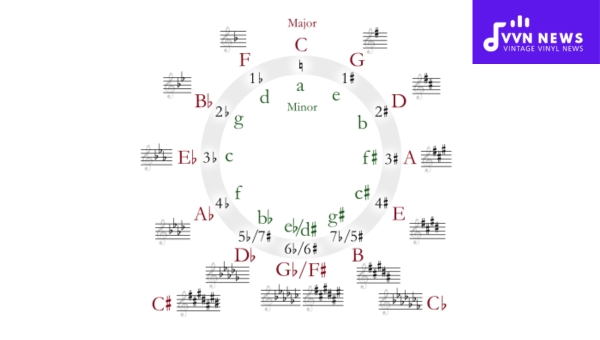Music, in its diverse and captivating forms, offers an incredible world of expression and creativity. One foundational aspect that allows us to explore this vast world is the key signatures.
Key signatures are integral for setting the music’s mood, guiding your fingers on the piano, or strumming patterns on the guitar.
Learning key signatures isn’t just about improving your performance skills. It’s also about gaining a deep knowledge of how different music pieces interact and contrast with each other.
By knowing key signatures, you’re equipping yourself with a compass to navigate through any music sheet or composition with confidence and finesse.
What are Key Signatures?
A key signature in music notation is a combination of sharps (#) or flats (b) (never both) that follow the clef at the beginning of a musical staff.
These symbols indicate the notes that are to be consistently raised (in case of sharps) or lowered (if flats).
Key signatures define the ‘home base’ of your music, dictating which notes will be played more often and which ones less so.
They drastically alter the sound and feel of the music, setting distinct personalities for different pieces.
Key signatures are primarily tied to scale – a succession of pitches ascending or descending – and can be either major or minor.
Notation varies depending on the instrument, but the principle remains the same – they provide crucial navigation points for creating harmonious melodies and chords.
How are Key Signatures Formed?
Key signatures are established based on a specific set of sharps or flats that arise from a piece’s underlying scale.
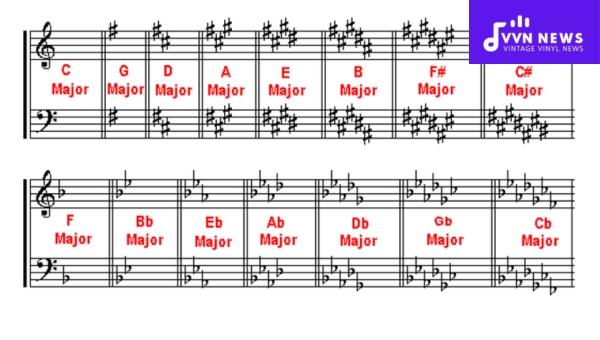
For example, the key of G Major has one sharp (F♯), whereas D Major has two sharps (F♯ and C♯).
What determines these sharps or flats is the scale from which the key originates.
Steps to Identify Key Signatures:
- Recognize the scale: Determine if it’s a major or minor scale.
- Note the sequence: Sharps and flats follow a specific order.
- Place on staff lines: Assign to the appropriate lines or spaces.
For visual learners, seek a circle of fifths chart that illustrates relations among key signatures magically, both in majors and relative minors.
Also Read: Phrygian Mode [Adding Exotic Flair To Your Musical Compositions]
What is the Order of Sharps and Flats?
When delving into key signatures, you’ll encounter sharps (♯) and flats (♭), which are not randomly placed but follow a specific sequence.
This sequence is crucial for musicians to grasp as it dictates the alteration of pitches within a key.
The Order of Sharps
The sharps appear in a fixed order: F, C, G, D, A, E, B. This can be remembered with mnemonic devices such as “Father Charles Goes Down And Ends Battle.”
As you progress from one sharp key to the next on the Circle of Fifths, you add these sharps in this precise order.
The Order of Flats
Flats also adhere to their pattern: B, E, A, D, G, C, F. Reverse mnemonics like “Battle Ends And Down Goes Charles’ Father” help recall this sequence.
Unlike sharps that ascend by fifths, flat keys descend by fifths on the Circle of Fifths.
These orders will greatly aid in swiftly identifying key signatures and ensuring accurate intonation and harmonization.
It’s like unlocking a map where each turn is dictated by these musical signs guiding you melodically through your musical journey.
How Does the Circle of Fifths Relate to Key Signatures?
The Circle of Fifths is a visual map that musicians use to identify the relationships between different keys.
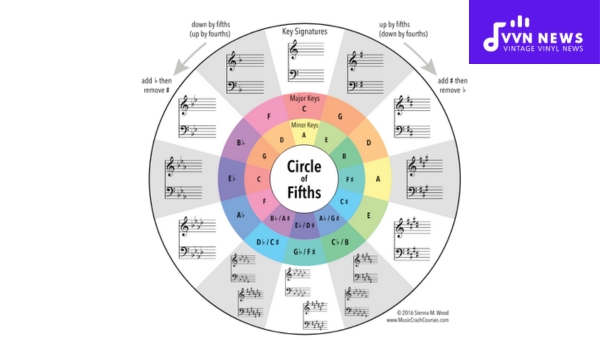
Like a clock, it consists of 12 points, each representing a key with its corresponding key signature.
- At 12 o’clock, you find C major, which is a key with no sharps or flats.
- Moving clockwise, each point increases by one sharp; for example, G major is at 1 o’clock with one sharp.
- Conversely, moving counterclockwise adds flats—F major at 11 o’clock has one flat.
This progression follows the pattern of fifths—a G is a fifth above C, and an F is a fifth below C.
A helpful way to think of it is this: if you ascend by perfect fifths starting from C (C-G-D-A-E-B/F♯), you add sharps. If you descend (C-F-B♭-E♭ etc.), flats are added.
For minor keys, their relative majors are positioned identically on the circle—the A minor contains no sharps or flats just like its relative C major.
This relationship between keys signifies that they share the same key signature but differ in tonal center.
Also Read: F Sharp Minor Pentatonic Scale [How To Use In Your Compositions]
What Are Enharmonic Equivalent Key Signatures?
Enharmonic equivalent key signatures represent scales that sound the same but are written differently.
For instance, the key of C sharp major, designated with seven sharps, is aurally indistinguishable from D flat major, which uses five flats.
Composers choose between these based on musical context and for ease of reading.
It’s essential to recognize that while they produce identical pitches, the theoretical approach in each is unique.
This duality offers flexibility in composing and interpreting music across various instruments – a true testament to the depth and adaptability of musical theory.
How to Write Key Signatures?
When writing key signatures, familiarity with the staff and the order of sharps and flats is imperative. Here are the steps to follow:
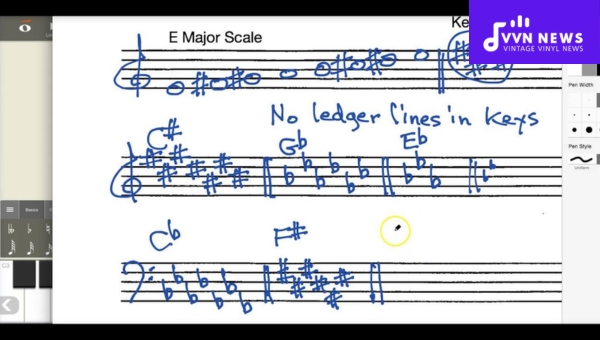
- Start by determining if your composition requires sharps(#) or flats(b).
- For sharps, begin with F# and move in the sequence of fifths: C#, G#, D#, A#, E#, and B#.
- For flats, start with Bb and proceed in fourths: Eb, Ab, Db, Gb, Cb, and Fb.
- Place the sharps or flats immediately after the clef sign on your staff.
- Ensure that these accidentals align with their corresponding note lines or spaces —for example, a B# should sit on the line representing B.
Remember to use double bar lines when switching key signatures within a piece—a clear indicator for performers.
By mastering these steps, you can confidently transcribe any melody into its proper context—allowing seamless transitions for instrumentalists from one key signature to another without missing a beat.
What’s the Difference Between a ‘Key’ and a ‘Scale’?
When delving into the realm of music theory, it’s essential to distinguish between keys and scales, as they form the backbone of melodic structure and harmony.
A key is a group of pitches that form the basis for a musical composition, setting a tonic or “home base” around which a piece revolves.
It imbues the music with a certain tonality—major or minor—and dictates the emotional and harmonic context.
On the other hand, a scale represents an ordered sequence of notes played in an ascending or descending order.
Scales can be used to construct melodies and harmonies within the framework of the key.
While scales follow specific interval patterns, such as whole and half steps, they don’t dictate tonality until applied within a musical context.
In essence, while all keys encompass scales, not all scales define keys.
They coexist symbiotically: scales provide building blocks for melodies and chords that enhance the character set by a piece’s key.
Also Read: Mastering Chords In A Minor [Improve Your Composition Skills]
What are Minor Key Signatures?
In music, minor key signatures inject a distinct emotion – often a sense of melancholy or introspection.
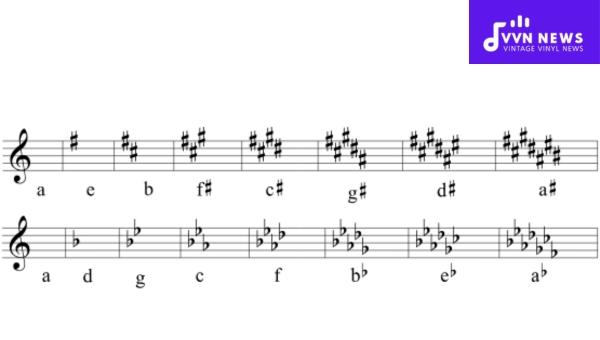
These signatures contain the same sharps or flats as their relative majors but start on a different note, typically the sixth scale degree. For example, A minor shares its lack of sharps and flats with C major.
Each minor key has a natural, harmonic, and melodic variation which subtly alter pitches to create unique sounds and feelings.
Witnessing an ‘m’ or ‘min’ next to the key indicates its minor status. Grasp these concepts firmly and you’ll add profound depth to your musical expression.
What are the 12 Sharp Keys?
Music’s tonal landscapes vary magnificently across the 12 sharp keys.
When a piece is in a sharp key, it means that either one or more of the notes will be raised, or “sharpened,” from their natural state every time they occur in the score.
These alterations are codified in the key signature, which you will find at the beginning of a staff, right after the clef symbol.
The sharp keys span from G major (or its relative minor, E minor), which has a single sharp, to C-sharp major (or A-sharp minor) boasting seven sharps. Here’s how they stack up:
- G Major / E minor: 1#
- D Major / B minor: 2#
- A Major / F# minor: 3#
- E Major / C# minor: 4#
- B Major / G# minor: 5#
- F# Major / D# minor: 6#
- C# Major / A# minor: 7#
Each subsequent key moves in what musicians refer to as the Circle of Fifths—every new key signature adds sharp to the existing pattern.
This progression forms an essential structure for negotiating music theory and practice alike.
What are the 12 Flat Keys?
The 12 flat keys form a significant region in the musical landscape, each featuring flats (♭) in their respective key signatures.
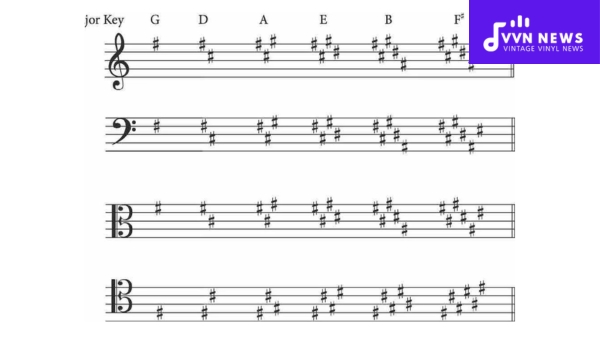
These keys range from one flat to seven flats and include the following: F Major (1 flat), B♭ Major (2 flats), E♭ Major (3 flats), A♭ Major (4 flats), D♭ Major (5 flats), G♭ Major (6 flats), and C♭ Major with its seven flats.
On the minor scale side, we encounter D Minor, G Minor, C Minor, F Minor, B♭ Minor, and E♭ Minor as their corresponding parallel minors.
Recognizing these key signatures equips musicians to navigate through compositions that consist of lower pitches predominantly.
Also Read: Phrygian Mode [Adding Exotic Flair To Your Musical Compositions]
FAQs
What is the easiest way to identify a key signature?
To identify a key signature, look at the number of sharps or flats; compare it with a key signature chart or use the circle of fifths for reference.
Can a piece of music change key signatures?
Yes, changes in key signatures within a piece are called modulations, and these occur frequently to add variety and contrast to music.
How does a key signature affect the emotion of a piece?
Key signatures help set the tonality; for example, major keys often sound bright and cheerful, while minor keys might feel somber or intense.
Why do some keys have multiple names?
Some keys are called enharmonic equivalents because they sound alike but are written differently, like C# major and Db major.
Is it necessary to memorize all key signatures?
While not strictly necessary, memorizing key signatures is highly beneficial for quickly reading music and the relationships between different keys.
Conclusion
Key signatures are essential as they define the harmonic landscape of a piece, marking a clear path for interpretation and performance.
Utilizing them is pivotal for any musician’s journey. Remember, it’s not just about recognizing sharps and flats, but also about appreciating their impact on musical expression.
If you’re a beginner or an experienced maestro, a firm grasp of key signatures will enhance your musical literacy and allow you to communicate effectively within the universal language of music.
